Many Types of Bins
What is important to you for your compost endeavor? Do you need to ensure that it’s pathogen free–and has no weed seeds–or will you not be composting questionable materials? Do you need it fast? Do you have time to manage your compost–or will you turn it infrequently, or never? Do you have a spot where no one will notice the compost–or will you have to locate it in an area that all your neighbors will see it?
There are many considerations to think about before deciding what type of compost bin and what method you want to use.
Here are some sample bins and methods, some expensive, some very inexpensive, and the advantages and disadvantages of each system to help you decide.
Plain Old Heap system
Slow composting is an easy way to turn yard wastes into a great soil amendment. For folks who have lots of land or have an area which is hidden from the neighbors, this will work. This is the best method for people who don’t have time to tend a hot compost pile. Simply mix yard wastes into a pile and let them sit for a year or so.
It is important to build the pile so that there will be enough air circulation that it won’t get anaerobic and stinky. Microorganisms, insects, earthworms, and other decomposers will slowly break down the wastes. A mixture of energy materials (nitrogen-grass & “greens”) and bulking agents (carbon-straw, wood chips & “browns”) provides the best food source for decomposition. Add fresh wastes to the pile by opening pile, placing fresh wastes into the center, and covering. This helps aerate the pile and also buries fresh wastes so they do not attract pests.
The pile above has added aeration because it is built on a plastic pipe with holes for air. Slow composting does not produce heat needed to kill many weed seeds. So, pull and compost weeds before they go to seed. If you put seeds in the compost pile, be prepared for more weeding! Thus, you don’t need a bin to compost. You can just build your pile on the ground! However, bins are useful for keeping your pile looking neat, retaining heat and moisture, and avoiding effects of wind and weather.
Wood Pallet Bin
Wood pallets make an easy-to-build, sturdy compost bin. Not only that, they’re free! Many companies still consider wood pallets a waste material and pay to have them hauled away with their garbage. If you see pallets at a business, ask if you can have them. Select four pallets of the same size to make the four sides of your bin. Connect the sides by tying them with string, rope, or wire, or by nailing them with double-headed nails. However you connect them, be sure to do it in a way that makes them easy to take apart when you want to move the pile or harvest the compost. Wood pallet bins are harder to turn regularly, so many people use them to compost slowly.
Circular Wire Mesh Bin
These bins are my personal favorite. They are easy to use when making hot compost, since you can open them up, set them aside, and turn the compost back into the bin. Some folks have several cooking at the same time,and when the volume has reduced enough, combine them into just one bin, then start making a fresh bin.
2 or 3 bin wood slat stationary system
This compost system is certainly not portable! Know the exact spot where you want to have your compost bins before building this type of system. It is great for neighborhoods that are picky about how your yard looks. The wooden slats in front can be removed, which makes it easier to move the compost from one bin to the other.
Wood Frame Wire Mesh Bin
Wood & wire bins are a little harder to make than the wire rings, and heavier to move around, but will fold for storage. It is easy to turn compost in these bins, because you can unhook and move the bin to the side, and fork your material right back in, adding the oxygen and water you might need.
Contained Plastic Commercial “Earth Machine”
Many municipalities are selling these compost bins to homeowners, sometimes at a subsidized price. While they’re not quite big enough to get very hot, they do produce nice compost. Just be careful not to put in seed from any plant that you would not want to see growing in your garden! Often, they are sold along with a winged poker that you can push down in the compost, and it helps get some oxygen into the compost on the way up. I find it easier simply to lift up the entire bin, put it to the side, and turn the compost into it! The bin does make for a tidy compost pile, although if you have lots of organic material, you may need 2 or 3 of them!
Rotating Drum Commercial machine
There are many companies that sell these “off the ground” type tumblers. They are expensive, but offer some advantages in ease of use and turning. Often, they come with fantastic promises, like “make compost in 2 weeks!”–or some such claim. While we’ve never been able to get compost that quickly from this method, the material will decompose, and critters like rodents and raccoons would have a hard time getting into it! Since the volume of the material inside is not sufficient to maintain heat, I would not recommend composting weeds gone to seed or diseased plant material, since they might come back to haunt your garden. One thing that this type of compost method lacks is worms, since it is not near enough to the ground to attract them. We found that adding a handful of worms from other compost bins helped speed the process.
Salvaged Wood Bin
A volunteer salvaged good board when she tore down her deck, and fashioned an excellent compost system.
Note the screen which she places above the second bin, where she can sift the finished compost for a fine product.
Here’s a closer look at the screen:








